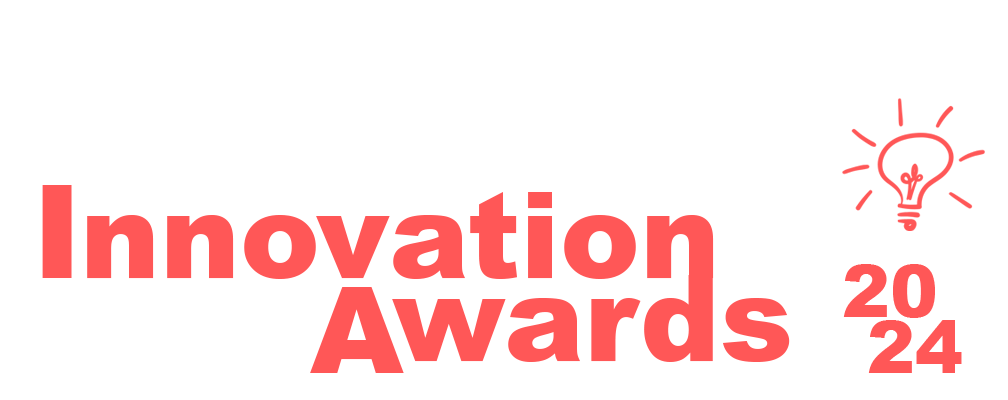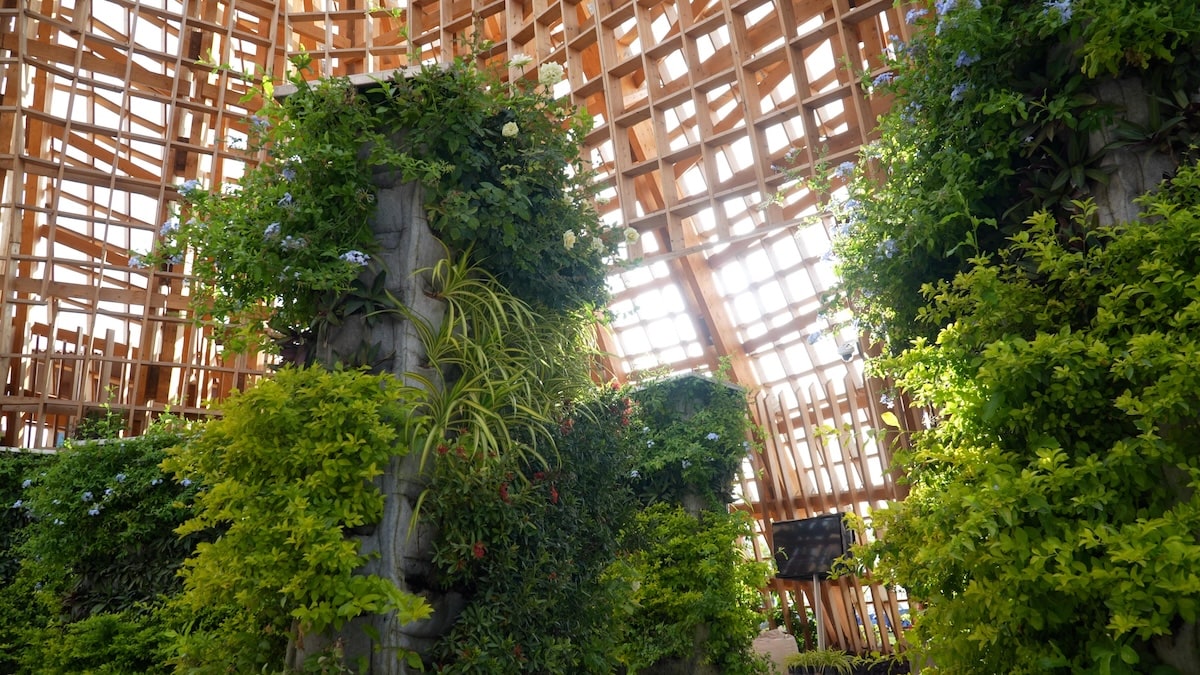AIPH is the International Association of Horticultural Producers. Our mission is to reignite and uphold an appreciation of living plants.
Expo Doha Qatar 2023 was the first International Horticultural Expo held in the Middle East region and in a desert climate. How impossible is that task – to green the desert? How challenging is it, if it is done in a way that can be considered sustainable? How can we spread awareness of plants for better living? We took the challenge to create a natural oasis on 995 m2 and answer those questions.
AIPH partnered with Dar Architects to create a pavilion inspired by local fishermen’s nets in Qatar. Blending traditional craftsmanship with innovative, hot-climate-friendly design, the pavilion puts plants at the centre of this experience.
Constructed with wooden slats up to 12.9 meters high, the gallery was designed to create microclimates, with plants carefully selected to thrive in them. We balanced familiar species, plants suited to hot weather, and those visitors might never have seen. Our structure, featuring shade, light, and wind corridors, ensured all plants survived the Expo, from humid October through winter’s extreme temperature shifts. Creating microclimates is a key design principle for diversifying and sustaining gardens in harsh conditions.

The structure, made from sustainably harvested glued laminated timber, reduces carbon emissions and enhances energy efficiency. Timber is durable, minimises construction waste, and the dry assembly system allows the pavilion to be dismantled without damage, enabling reuse or recycling at the end of its lifecycle.
We brought together over 60 varieties of plants, or around 1900 stems and trunks, forming different zones and educational displays. Visitors were greeted with “Hot and Arid” plants collection with explanations on mechanisms helping them adapt. The experience continued with “Edible plants”, “Tropical plants” and “Night flowering plants”. Plants with similar water needs were grouped together to save water and allow optimal growth. Smart irrigation system was installed on vertical displays which hosted the biggest number of plants.
The majority of pots in the pavilion were made of fibre, a lightweight material easy to reuse, which promotes root health, and has excellent water retention properties, reducing the frequency of watering. The majority of plants were sourced locally, with the help of local nursery and plant importer Plaza Hollandi. The “lush tropical” plants area was a special, secluded space in the gallery featuring a seating area, which evoked an indoor space. Few specimens of each tropical plant variety (12 varieties) were imported to diversify the display and showcase how those could look in an indoor environment.

AIPH designed and created signage, audioguide and video stories throughout the Pavilion, in Arabic and English, with a special track available for kids. The messages were aiming at helping the visitors discover the power and benefits of plants, their role in fighting desertification and what efforts can be taken individually for sustainable living. Based on our satisfaction questionnaire, 78,3 % of visitors felt inspired to try growing their own plants, an important step to a cultural shift towards embracing real greenery. Overall satisfaction rate reached 98,2% (rating the experience as “Excellent” and “Good”)

AIPH is delighted to continue our mission and promote the Green City philosophy. Our Pavilion in Expo Doha reflects this goal: helping cities integrate the living green for its functional benefits in order to become healthy, successful and liveable urban spaces.
Exhibit
Our temporary exhibit at Expo Doha 2023, titled “Oasis of Life – Uncovering the Power of Plants,” spanned 995 m² and was part of the first International Horticultural Exhibition in the Middle East and in a desert climate. As AIPH, we focused on immersing our audience by placing plants at the heart of our exhibit.
Plants are a universal experience — some see them as food, others enjoy them in cities, and many cultivate them for pleasure. How to make a subject so common, immersive and exciting? We looked for answers in research and practice. Over the past 3 decades, there has been growing concern about the decline in the connection between people and nature. Often, people don’t notice nature. Research evidence suggests that simply noticing nature improves a person’s wellbeing. At the same time, people often notice well what they can relate to. What touches them personally, resembles them or teaches them something they can apply. Our objective was clear: help our visitors notice plants and engage with them, to make them happier.
We used these principles to design our exhibit, featuring a 12.9-meter-high structure that served two purposes: creating microclimates for over 60 plant varieties to thrive in the harsh desert and shaping an exploratory space. This layout invites visitors to walk through it, mimicking a natural canyon and encouraging interaction with the environment.
Visitors, primarily from the Middle East, began their journey with familiar plants—native species and those adapted to hot, arid climates. Our Pavilion Hosts welcomed the guests, offering a guided tour or a conversation to aid in individual exploration. They encouraged visitors to touch the plants, demonstrating unique adaptations like waxy surfaces, thick leaves, and hairy textures that help the plants survive. This sensory experience enhanced visitors’ connection to the nature around them.

Exploring together with our guests, we have identified a gap in understanding how to nurture living greenery. In Qatar, many have had negative experiences with real plants both indoor and outdoor and ended up replacing them with artificial alternatives or nothing at all. Some doubted our plants were real, and some tried picking a leaf – which was not expressly prohibited. We allowed this way of interaction with our exhibit as well, because in mild Doha’s winter conditions, plants would grow even bigger when pruned!

Did you know plants have passports? Where do plants come from? Who powers the horticulture industry, and how do they innovate for fresher, smarter, and more beautiful plants? To cater to different interests, we offered four educational tracks: Journey to Market, The Power of Plants, Green City Principles, and the History of International Horticultural Expos. These were narrated through plants, an audioguide, video displays, signage, and our Hosts. We also created a kids’ track with simpler explanations and illustrations in English and Arabic.

A special area was designed for rest and relaxation, featuring lush tropical plants and an educational track on “The Power of Plants.” These plants can thrive indoors year-round in Qatar’s climate. We noted the time spent in this zone per visitor: on average it was the longest in this area.
Feedback from our visitors revealed a significant shift in mindset. Many who initially had little interest in or understanding of real plants expressed newfound enthusiasm after their visit. 78,3 % of visitors felt inspired to try growing their own plants. 72,9 % of visitors described our pavilion as relaxing, and 68,8% as educational. Overall satisfaction rate reached 98,2% (rating the experience as “Excellent” and “Good”).
The Pavilion effectively challenged existing norms and promoted a cultural shift towards embracing real greenery. We also hope that it made our 210,087 visitors happier!

Partners
- DAR Architects – Pavilion’s Structure Design
- Ashghal – Public works authority of Qatar – Construction
- Plaza Hollandi – Plants and maintenance
- Sam Lemheney – Creative Event Solutions – Onsite supervision for set-up, initial selection of plants, theme curation
- LOSFEE Architecture & Landscape Design – provision of additional soft shading
- LES Qatar – rental of monitors
- AIPH Member Organisations – source of inspiration and stories from the industry, that were reworked into video and audioguide content
- Expo Doha 2023 Qatar – main sponsor



